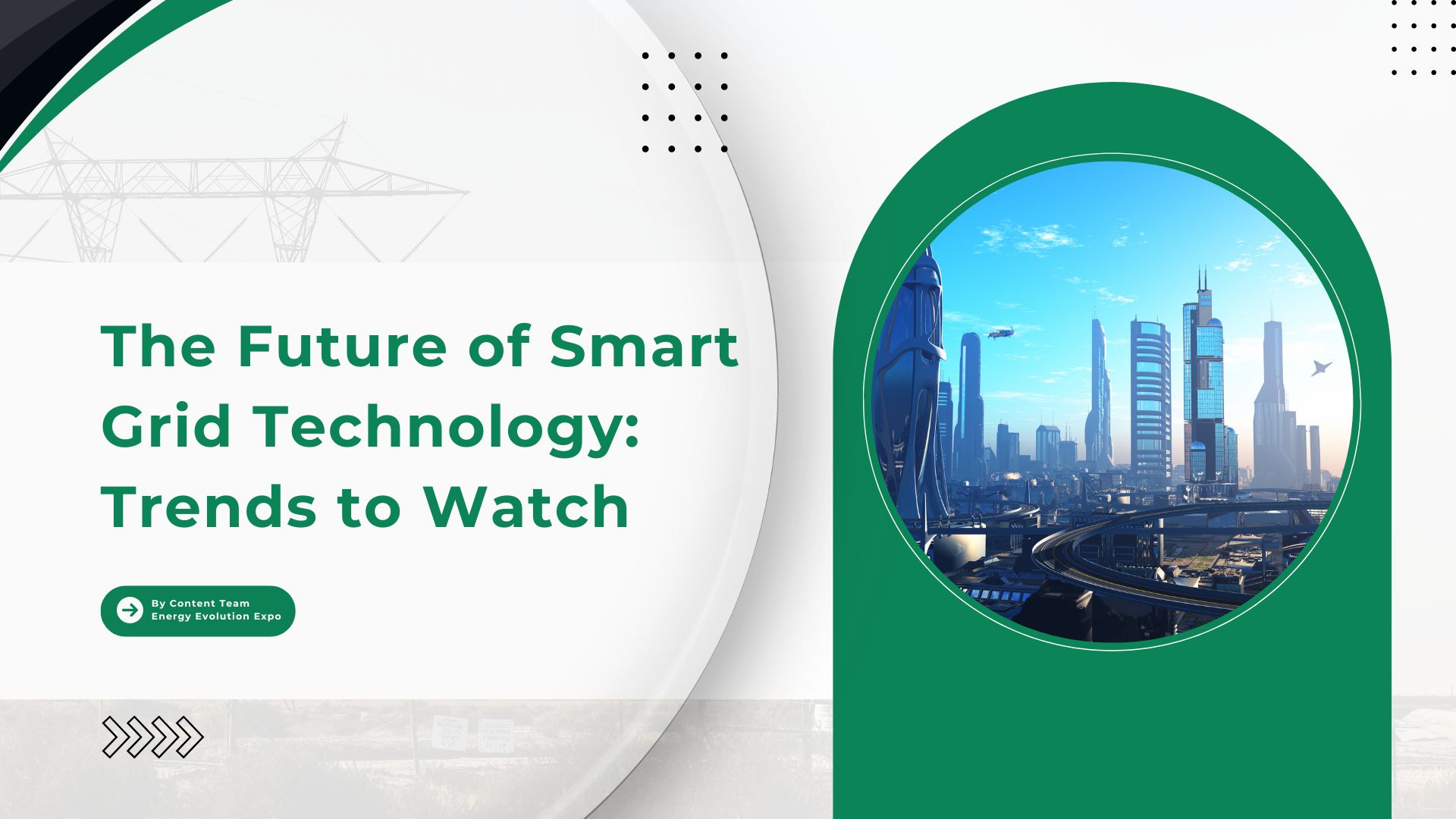The Future of Smart Grid Technology: Trends to Watch

About Grid Technology
The forthcoming advancements in smart grid technology are poised to bring about significant transformations, propelled by a diverse range of emerging trends and innovations. The incorporation of cutting-edge technologies and the escalating need for effective energy management are restructuring our perception and engagement with electrical grids. Noteworthy trends and advancements in the smart grid industry are highlighted here, showcasing how various countries are leveraging these trends.

1. Integration of Renewable Energy Sources:
Upcoming advancements in smart grid technology are anticipated to result in substantial transformations, driven by a diverse array of emerging trends and innovations. The integration of state-of-the-art technologies and the growing necessity for efficient energy management are reshaping our understanding and interaction with electrical grids.
This article highlights notable trends and progressions in the smart grid sector, illustrating how different nations are capitalizing on these trends. An exemplary instance is Germany’s Energiewende (Energy Transition) policy, which involves integrating renewable energy sources into the grid. By significantly boosting its utilization of wind and solar power, supported by smart grid technologies that address the intermittent nature of these sources.
Germany’s smart grid plays a pivotal role in balancing the grid through regulating the output from traditional power plants and utilizing advanced energy storage solutions.
Denmark has become a leader in wind energy, with about 50% of its electricity coming from wind power. The country’s smart grid uses real-time data and advanced forecasting to integrate this renewable energy source effectively, maintaining grid stability and reliability.
2. Advanced Metering Infrastructure (AMI):
The adoption of smart meters in the United States is widespread, with over 100 million units installed nationwide. Leading states such as California and Texas utilize Advanced Metering Infrastructure (AMI) to offer consumers detailed insights into their energy consumption, facilitating improved energy management and fostering the use of dynamic pricing models to incentivize off-peak energy usage.
Enel in Italy has notably implemented a significant AMI project, deploying more than 30 million smart meters. This undertaking has resulted in enhanced billing precision, improved outage response, and the introduction of innovative services like time-of-use pricing. AMI plays a fundamental role in smart grid technology by providing real-time energy consumption data to consumers and utility companies through smart meters.
This data empowers better energy management, quick outage identification, and the implementation of dynamic pricing strategies aimed at promoting energy conservation during peak demand periods.
3. Energy Storage Solutions:
Energy storage technologies, with a focus on battery storage, are becoming increasingly crucial for smart grids. They play a significant role in storing surplus energy produced during times of low demand and releasing it during peak demand periods. Advances in battery technology, such as enhancements in lithium-ion batteries and the introduction of new materials like solid-state batteries, are improving the effectiveness and storage capacity of energy systems.
In Australia, there is a significant investment in battery storage to complement the country’s considerable solar power capacity. Projects like the Hornsdale Power Reserve in South Australia, which utilizes Tesla batteries, demonstrate how large-scale storage can stabilize the grid by storing excess energy when demand is low and discharging it during peak periods.
China is also rapidly expanding its energy storage capacity, as seen in projects like the Dalian Flow Battery Energy Storage Power Station. This extensive vanadium flow battery system aids in managing the grid’s renewable energy sources and enhancing grid reliability.
4. Grid Modernization and Digitalization:
Grid modernization is the process of enhancing existing infrastructure through the integration of digital technologies to improve operational efficiency, reliability, and resilience. This involves deploying sensors, IoT devices, and advanced communication networks that facilitate real-time monitoring and automated management of the grid.
Additionally, digital twins, which are virtual representations of physical assets, are utilized to simulate and forecast grid performance under diverse scenarios. The National Grid in the UK is currently undergoing significant modernization efforts in order to facilitate the transition to renewable energy sources and electric vehicles.
By leveraging digital twins to conduct predictive maintenance and continuous monitoring, the National Grid aims to bolster grid efficiency and reliability. Similarly, India is embarking on smart grid initiatives to revamp its aging grid infrastructure. Initiatives like the Smart Grid Pilot Project in Puducherry use advanced sensors, IoT devices, and data analytics to improve grid management and reduce losses due to theft and technical issues.
5. Cybersecurity Enhancements:
Smart grids are increasingly digitized and interconnected, making them susceptible to cyber-attacks. Therefore, there is a crucial need to prioritize cybersecurity. This entails implementing sophisticated security measures like encryption, anomaly detection systems, and stringent access control protocols to safeguard the grid from possible threats.
The U.S. Department of Energy has introduced the Cybersecurity for Energy Delivery Systems (CEDS) program to bolster the resilience and security of the country’s essential energy infrastructure. This initiative involves creating and implementing cutting-edge cybersecurity solutions tailored for smart grids.
6. Demand Response Programs:
In demand response programs, the focus is on adjusting the demand for power rather than altering the supply. These initiatives aim to motivate consumers to decrease their energy consumption during peak periods by offering incentives or applying dynamic pricing strategies.
The implementation of smart grids plays a crucial role in supporting these programs by providing the necessary infrastructure and data analysis capabilities to oversee and control energy usage patterns. For example, Japan has introduced demand response schemes that incentivize consumers to decrease energy consumption during peak hours.
Projects like the Negawatt Market facilitate energy trading among consumers who have saved energy, leveraging smart grid technology to monitor and facilitate these transactions in real time. Similarly, South Korea has integrated demand response programs into its smart grid project on Jeju Island, leveraging real-time data and smart meters to prompt consumers to shift their energy usage to off-peak periods, ultimately enhancing grid reliability.

7. Microgrids and Decentralization:
An exemplary illustration of a community microgrid is the Brooklyn Microgrid project in New York. This initiative enables residents to produce, store, and exchange solar energy at a local level utilizing blockchain technology, thereby bolstering energy resilience and fostering local energy generation.
Puerto Rico is also implementing microgrids in response to frequent power failures, with a focus on enhancing energy resilience. These microgrids, typically powered by solar energy, deliver consistent electricity to critical facilities such as hospitals and emergency centers.
Microgrids are self-contained energy systems that can function independently or in conjunction with the main grid, heightening energy resilience by enabling communities to sustain power supply during extensive grid failures. The shift towards decentralization, facilitated by the emergence of microgrids and distributed energy resources (DERs), advocates for a more adaptable and resilient energy framework.
8. Electric Vehicles (EVs) Integration:
Increasing adoption of electric vehicles poses both challenges and opportunities for smart grids. Electric vehicles can serve as mobile energy storage units, enabling potential vehicle-to-grid (V2G) integration where vehicles can supply power back to the grid during peak demand.
This two-way energy flow demands advanced management and coordination, which are enabled by smart grid technologies. Norway stands out as a global leader in electric vehicle adoption, with electric cars representing more than 50% of new car sales. The Norwegian smart grid incorporates electric vehicles as mobile storage units, supporting V2G technology that allows vehicles to provide power back to the grid during peak demand.
A similar initiative is underway in the Netherlands, where the integration of electric vehicles with the smart grid is being pioneered. Initiatives like the Lombok neighborhood project in Utrecht utilize bi-directional charging stations that enable electric vehicles to supply electricity to both homes and the grid, facilitating energy storage and grid stability.
9. Artificial Intelligence and Machine Learning:
Artificial intelligence (AI) and machine learning technologies are currently being employed to enhance the optimization of grid operations. These advanced technologies have the capability to forecast energy consumption tendencies, improve grid stability, and facilitate predictive maintenance through the examination of expansive datasets obtained from different grid components.
Utilizing AI-driven algorithms enables operators to make instantaneous decisions that optimize the overall efficiency and dependability of the grid. In Toronto, the utility provider Alectra is utilizing AI and machine learning to anticipate energy consumption patterns and refine grid operations.
These technologies are instrumental in prompt decision-making, consequently refining grid efficiency and trimming operational expenses. Additionally, Singapore’s Smart Nation initiative integrates AI into the management of its electricity grid. AI algorithms scrutinize information sourced from sensors and smart meters to enhance energy distribution and anticipate maintenance requirements, ensuring the grid remains reliable and efficient.
10. Blockchain for Energy Trading:
Blockchain technology presents a decentralized and secure method for recording transactions, which is particularly suitable for energy trading purposes. Platforms for peer-to-peer (P2P) energy trading, powered by blockchain, enable consumers to engage in direct energy transactions, thereby fostering local energy generation and consumption. This movement towards more distributed energy systems empowers consumers by increasing their participation in the energy market.
For example, the German company Sonnen utilizes blockchain technology to facilitate peer-to-peer energy trading among households with solar panels. This decentralized approach allows consumers to directly exchange excess energy, thereby boosting local energy usage and production.
Similarly, the UK-based company Electron is actively developing blockchain platforms to streamline energy trading processes. These platforms contribute to the establishment of decentralized energy markets, enabling smooth transactions for buying and selling energy, ultimately promoting the adoption of renewable energy sources and enhancing grid flexibility.
Advancements in smart grid technology are expected to transform the energy industry by enhancing efficiency, reliability, and sustainability. Through the integration of renewable energy sources, improvement of grid infrastructure, and adoption of cutting-edge technologies like AI and blockchain, smart grids will revolutionize electricity generation, distribution, and consumption. These developments offer the dual benefits of better energy management and cost reduction while also making significant contributions to environmental preservation and energy security.
In order to fully harness the potential of smart grids and pave the way for a sustainable energy future, it is imperative that all stakeholders, ranging from utility companies to technology providers, policymakers, and consumers, actively participate and stay abreast of the latest advancements in smart grid technology. This collaborative effort is key to realizing the transformative impact of smart grids and ensuring a sustainable energy landscape.
We need to keep up with all recent innovations to reap maximum benefits and to facilitate a better understanding of the latest developments and trends in the Renewable energy Industry, various Conferences and Expos, which bring the Industry leaders together, serve as an all-inclusive platform.
The Energy Evolution Awards, Conference, and Expo organized by Next Business Media is making its debut in Spain in 2025. It will be a leading forum dedicated to honoring excellence in Energy Technology, showcasing innovations, and fostering collaborations. The events unite industry leaders, and visionaries to explore the latest advancements, tackle key challenges, and shape the future of Energy.
The Energy Evolution Awards, Conference, and Expo will celebrate outstanding achievements, promote sustainable practices, and drive the Energy Industry forward into a technologically advanced sustainable era. Energy Evolution Awards, Conference, and Expo will be a platform for cultivating innovation and shaping a brighter, more efficient energy landscape.





